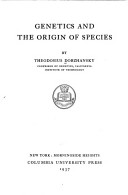Genetics and the Origin of Species

Cover of the first (1937) edition
|
|
| Author | Theodosius Dobzhansky |
|---|---|
| Series | Columbia University Biological Series (volume 11) |
| Subject | Evolutionary biology |
| Published | Columbia University Press |
| Pages | 364 |
| OCLC | 766405 |
| LC Class | QH366 .D6 |
Genetics and the Origin of Species is a 1937 book by the Ukrainian-American evolutionary biologist Theodosius Dobzhansky. It is regarded as one of the most important works of the modern evolutionary synthesis. The book popularized the work of population genetics to other biologists, and influenced their appreciation for the genetic basis of evolution. In his book, Dobzhansky applied the theoretical work of Sewall Wright (1889-1988) to the study of natural populations, allowing him to address evolutionary problems in a novel way during his time. Dobzhansky implements theories of mutation, natural selection, and speciation throughout his book to explain habits of populations and the resulting effects on their genetic behavior. The book explains evolution in depth as a process over time that accounts for the diversity of all life on Earth. The study of evolution was present, but greatly neglected at the time. Dobzhansky illustrates that evolution regarding the origin and nature of species during this time in history was deemed mysterious, but had expanding potential for progress to be made in its field.
In Darwin's theory of natural selection, more organisms are produced than can survive. Some have variations that give them a competitive advantage, and they have the best chance of surviving and procreating. The main element lacking in the theory was any mechanism that would allow organisms to pass on these favorable variations. Lacking such a mechanism, the theory of evolution faced competition from theories such as neo-Lamarckism, in which the environment acted directly on organisms, changing their structures. Darwin did not know that the monk Gregor Mendel was already working on experiments that would explain inheritance in terms of units of heredity that we now call genes.
When Mendelian genetics was rediscovered by several scientists, it initially increased the confusion. The Dutch botanist Hugo de Vries developed a theory called mutationism in which most variations were inconsequential and could not lead to species change. Instead, new species were formed by large mutations. At first, geneticists tended to support mutationism; but in the 1920s and 1930s a group of theoretical geneticists – particularly Ronald Fisher, J. B. S. Haldane and Sewall Wright – showed that Mendel's laws could explain continuous variation in biological characteristics; and that natural selection could act cumulatively, giving rise to large changes. Their work provided a theoretical framework for incorporating genetics into the theory of evolution.
...
Wikipedia
